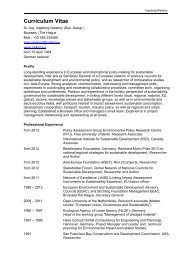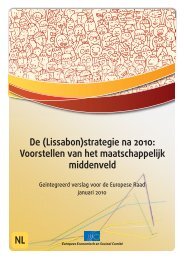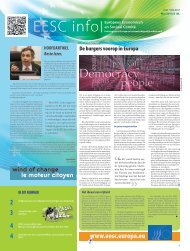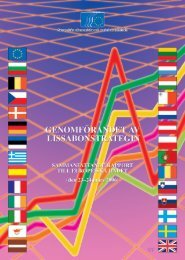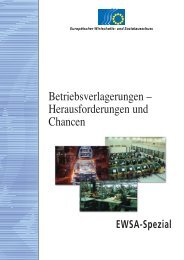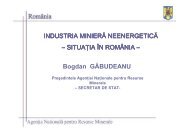European Cycling Lexicon - Economic and Social Committee - Europa
European Cycling Lexicon - Economic and Social Committee - Europa
European Cycling Lexicon - Economic and Social Committee - Europa
Create successful ePaper yourself
Turn your PDF publications into a flip-book with our unique Google optimized e-Paper software.
“The <strong>European</strong> <strong>Economic</strong> <strong>and</strong> <strong>Social</strong> <strong>Committee</strong> calls for clear prioritisation of<br />
objectives, with precedence for local public transport, walking <strong>and</strong> cycling over<br />
car infrastructure. This is the only way to improve living <strong>and</strong> environmental<br />
conditions in metropolitan areas.” 1<br />
P<br />
PREFACE<br />
Mario M Sepi, President of the <strong>European</strong> <strong>Economic</strong> <strong>and</strong><br />
<strong>Social</strong> S <strong>Committee</strong><br />
Most M of us remember how thrilled we were as children,<br />
when w our parents taught us to cycle, preventing us<br />
from f falling with a helping h<strong>and</strong>, yet encouraging<br />
us u to steer <strong>and</strong> balance ourselves until we finally<br />
experienced the jo<br />
joy of rolling effortlessly over the paving. A wonderful<br />
feeling of freedom, reminiscent of flying.<br />
Many of us have retained this enthusiasm for cycling also as adults, choosing<br />
the bike as their means of transport between home <strong>and</strong> work, benefiting<br />
from the fact that, especially in urban areas, it is the fastest, healthiest <strong>and</strong><br />
cheapest means of transport for medium distances, or enjoying bike rides at<br />
weekends <strong>and</strong> during our vacation.<br />
1 Opinion of the <strong>European</strong> <strong>Economic</strong> <strong>and</strong> <strong>Social</strong> <strong>Committee</strong> on Transport in urban <strong>and</strong> metropolitan areas<br />
(Exploratory opinion), TEN/276 - CESE 615/2007<br />
3
4<br />
Others, however, may refrain from cycling because of inadequate infrastructure<br />
or because they feel that a human powered vehicle cannot meet their mobility<br />
<strong>and</strong> transport needs or does not correspond to their status.<br />
But these things can change for the better rather rapidly, as a French<br />
colleague told me:<br />
“The examples of cities like Paris, Barcelona or even Brussels, with their<br />
self-service bike rental systems <strong>and</strong> their recent improvements in cycling<br />
infrastructure show that cycling can become very popular in a very short time.”<br />
The <strong>European</strong> <strong>Economic</strong> <strong>and</strong> <strong>Social</strong> <strong>Committee</strong> (EESC) is the EU body,<br />
established by the Treaty of Rome, in which civil society organisations<br />
from all EU member states participate in EU policy making. In our official<br />
opinions, which are jointly developed by representatives from employer<br />
organisations, trade unions <strong>and</strong> various interest groups such as consumer<br />
groups or environmental organisations, we have clearly stated (<strong>and</strong> I quote<br />
in the languages of the opinion’s drafts-persons) that<br />
“The <strong>Committee</strong> calls for clear prioritisation of objectives, with precedence for<br />
LPT, walking <strong>and</strong> cycling over car infrastructure. This is the only way to improve<br />
living <strong>and</strong> environmental conditions in metropolitan areas.” 2<br />
In its opinion on the promotion of cross-border cycle transport the EESC<br />
dem<strong>and</strong>s<br />
“In Europe every train, including high-speed international trains, should<br />
be obliged to make space available for transporting, among other things,<br />
bicycles.<br />
Minimum quality st<strong>and</strong>ards should be introduced for cycling infrastructure<br />
built with the aid of <strong>European</strong> subsidies.<br />
2 Opinion of the <strong>European</strong> <strong>Economic</strong> <strong>and</strong> <strong>Social</strong> <strong>Committee</strong> on Transport in urban <strong>and</strong> metropolitan areas<br />
(Exploratory opinion), TEN/276 - CESE 615/2007
<strong>Cycling</strong> policy must also be integrated into the further development of <strong>European</strong><br />
policy in the fields of spatial planning (including urban development policy),<br />
the environment, the economy, health, training <strong>and</strong> education.<br />
The <strong>European</strong> Commission must continue to subsidise the creation of Euro Velo<br />
Routes so that a complete <strong>European</strong> Network of Cycle Routes, a TEN (Trans-<br />
<strong>European</strong> Network) for cycling, comes into existence.<br />
The EESC recommends that EU subsidy budgets also be made available for the<br />
development <strong>and</strong> maintenance of cycling infrastructure.” 3<br />
3 Opinion of the <strong>European</strong> <strong>Economic</strong> <strong>and</strong> <strong>Social</strong> <strong>Committee</strong> on the Promotion of cross-border cycle transport<br />
TEN/277 - CESE 616/2007<br />
5
6<br />
With this innovation – the first <strong>European</strong> <strong>Cycling</strong> <strong>Lexicon</strong> that contains key<br />
terms of cycling, cycling infrastructure <strong>and</strong> different types of cycles for different<br />
transport needs in 27 languages, including all 23 official languages of the EU<br />
– the EESC wants to<br />
• help <strong>European</strong> citizens <strong>and</strong> visitors of Europe cycling abroad to<br />
communicate in bicycle shops, travel agencies, railway stations <strong>and</strong> hotels<br />
• raise awareness about infrastructure that facilitates cycling in order to<br />
inspire politicians, planners <strong>and</strong> peoples’ organisations (<strong>and</strong> here I especially<br />
thank our translators, who had to cover new linguistic territory in those<br />
cases where the concepts in question did not exist yet in their language)<br />
• raise awareness about the many forms of human powered vehicles that<br />
meet many different mobility needs in a sustainable manner <strong>and</strong><br />
• make the point that cycling policy is not only a local but also a <strong>European</strong><br />
issue. 4<br />
It is in this spirit that the EESC has also become a signatory of the Brussels<br />
Charter 5 on a better cycling policy.<br />
As an important workplace in the Brussels EU district we encourage<br />
colleagues to come to work by bike <strong>and</strong> other sustainable modes of transport<br />
in our staff transport plan <strong>and</strong> by organising monthly Friday-Bikedays.<br />
The EESC Secretary-General Martin Westlake (centre) <strong>and</strong> staff attending Friday Bikeday<br />
May we experience the joy of cycling not only on international<br />
car-free day but all year round!<br />
4 Please also visit our web site where you can find — <strong>and</strong> soon also add — further languages <strong>and</strong> terms:<br />
http://www.eesc.europa.eu/sections/ten/european-cycling-lexicon<br />
5 See page 8
PREFACE<br />
Manfred M Neun, President of the <strong>European</strong> Cyclists’<br />
Federation<br />
F<br />
<strong>Cycling</strong> C will be an increasingly important element of<br />
urban u mobility of the future. Cities <strong>and</strong> regions worldwide<br />
will w improve their quality of life by becoming cyclingfriendly<br />
f – this is a significant advantage to competition.<br />
Car-oriented Car oriented cities wil<br />
will need to “re-cycle” themselves, as the official motto of<br />
the Velo-city 2009 conference in Brussels states. The conference turned out<br />
to be a tremendous success. Its milestone was the signing of the “Charter of<br />
Brussels” in the <strong>European</strong> Parliament by cities across Europe. Cities committed<br />
themselves to raise the level of cycling in the modal split to 15 % (or more) by<br />
2020. For the average <strong>European</strong> city this means a tripling in the level of cycling<br />
– a very concrete “re-cycling” aim!<br />
Being the <strong>European</strong> voice of cyclists, the ECF is very pleased that in times of<br />
climate change the value of the bicycle as a zero emission vehicle is being<br />
newly appreciated. It makes a new urban lifestyle possible.<br />
We would like to sincerely thank the <strong>European</strong> <strong>Economic</strong> <strong>and</strong> <strong>Social</strong> <strong>Committee</strong><br />
whose enthusiasm made this multi-lingual <strong>European</strong> <strong>Cycling</strong> <strong>Lexicon</strong> possible.<br />
Meeting people <strong>and</strong> experiencing the diversity <strong>and</strong> beauty of our continent on<br />
the bicycle – there is no better way to move around!<br />
7
8<br />
CHARTER OF BRUSSELS<br />
CYCLING CONTRIBUTES TO<br />
LIVEABLE CITIES, EFFICIENT URBAN TRANSPORT, LESS CONGESTION, LESS TRAFFIC NOISE, HEALTHY PHYSICAL<br />
ACTIVITY, ROAD SAFETY, CLEAN AIR, FIGHTING CLIMATE CHANGE, SAVING FOSSIL FUELS AND SUSTAINABLE<br />
TOURISM.<br />
ON THE OCCASION OF THE VELO-CITY® 2009 CONFERENCE IN BRUSSELS<br />
UNDERSIGNED CITIES COMMIT THEMSELVES:<br />
A) TO SET A TARGET OF AT LEAST 15% FOR THE SHARE OF CYCLING IN THE MODAL SPLIT OF TRIPS FOR THE<br />
YEAR 2020 AND OF FURTHER GROWTH IF THIS TARGET ALREADY IS ACHIEVED<br />
B) TO SET A TARGET OF - 50% FOR CYCLISTS RUNNING THE RISK OF HAVING A FATAL ACCIDENT FOR THE<br />
YEAR 2020<br />
C) TO WORK ON A BICYCLE PARKING AND ‘ANTI BICYCLE THEFT POLICY’<br />
D) TO PARTICIPATE IN AND TO SET UP PROJECTS TO INCREASE CYCLING TO SCHOOL AND TO WORK<br />
E) TO CONTRIBUTE TO MORE SUSTAINABLE TOURISM BY INVESTING IN MEASURES TO IMPROVE AND TO<br />
INCREASE BICYCLE TOURISM<br />
F) TO COOPERATE CLOSELY WITH THE BICYCLE USER ORGANISATIONS, THE BICYCLE RETAILERS ORGANIZATION<br />
AND THE BICYCLE INDUSTRY ORGANIZATIONS AND OTHER STAKEHOLDERS AS THE POLICE, CONSULTANTS<br />
AND EXPERTISE CENTERS, ARCHITECTS AND BUILDERS OF INFRASTRUCTURE TO ACHIEVE THE TARGETS, AND<br />
CALL UPON ALL OTHER EUROPEAN CITIES TO FOLLOW OUR EXAMPLE.<br />
THIS CITY, TOGETHER WITH ALL THE OTHER CITIES SIGNING THIS CHARTER, CALL UPON THE EUROPEAN<br />
COMMISSION AND THE EUROPEAN PARLIAMENT:<br />
A) TO SET A TARGET OF AT LEAST 15% FOR THE SHARE OF CYCLING IN THE MODAL SPLIT OF TRIPS IN<br />
EUROPE FOR THE YEAR 2020<br />
B) TO ESTABLISH THE POST OF EUROPEAN BICYCLE OFFICER IN THE ADMINISTRATION OF THE EUROPEAN<br />
COMMISSION<br />
C) TO CREATE A PARLIAMENTARY INTERGROUP ‘CYCLING’ IN THE EUROPEAN PARLIAMENT<br />
D) TO PUT ADEQUATE BUDGETS AT THE DISPOSAL OF EUROPEAN PROGRAMS FOR THE FINANCIAL SUPPORT OF<br />
CITIES AND NGOS PROMOTING CYCLING IN EUROPE.<br />
FURTHERMORE, THE SIGNERS OF THIS CHARTER CALL UPON ALL AUTHORITIES WORLDWIDE, AT ALL LEVELS TO<br />
STRONGLY PROMOTE CYCLING AND TO INCORPORATE CYCLING INTO ALL AREAS OF POLICY (HEALTH, SPATIAL<br />
PLANNING, CITY MANAGEMENT, ECONOMY, MOBILITY AND TRAFFIC, LEISURE, SPORTS, TOURISM).
SOME CYCLING STATISTICS<br />
(Find more statistics on our website<br />
http://www.eesc.europa.eu/sections/ten/european-cycling-lexicon)<br />
<strong>Cycling</strong> in Europe<br />
• In 2000 there were ca. 200 million bicycles in the EU 15 (compared with<br />
160 million cars <strong>and</strong> 493 million inhabitants), but only 10% of the bikes<br />
were used on any given day. (Sources: Eurostat, Les Ludson, 2000,Transport<br />
<strong>and</strong> tourism: Cycle tourism – a model for sustainable development<br />
in Journal of sustainable tourism, Vol 8 No 5)<br />
(http://www.bfa.asn.au/cms/uploads/tourism/lumsdon.pdf)<br />
• On average a Dutch person cycles 2.3 km a day <strong>and</strong> a Spaniard only<br />
0.1 km (Source: <strong>European</strong> Commission, DG Transport; 2002, EU energy<br />
<strong>and</strong> transport in figures, pocketbook)<br />
• 26% of all trips in the Netherl<strong>and</strong>s are made by bicycle. In Great Britain<br />
the figure is only 2%. (Source: “<strong>Cycling</strong> in the Netherl<strong>and</strong>s”, Fietsberaad,<br />
2009; www.bicyclecouncil.org)<br />
• Improving cycling infrastructures can increase cycling levels in a very<br />
short time. Barcelona has introduced a self-service bicycle hire system<br />
in March 2006 with bikes shared across the city (similar to the<br />
Velib-system in Paris). As of November 2007, the system had been<br />
used more than 2 750 000 times, representing 8 000 000 km of travel.<br />
(Source: http://en.wikipedia.org/wiki/Bicing)<br />
• Most trips in <strong>European</strong> cities are shorter than 6 km, a distance that can easily<br />
be travelled by bike, often more quickly than by car). (Source: “<strong>Cycling</strong> in<br />
the Netherl<strong>and</strong>s”, Fietsberaad, 2009; www.bicyclecouncil.org)<br />
<strong>Economic</strong> benefits <strong>and</strong> energy efficiency of cycling<br />
• The average purchasing price of a new bicycle is EUR 579, more than 30<br />
times less than that of an average car. (Source: “<strong>Cycling</strong> in the Netherl<strong>and</strong>s”,<br />
Fietsberaad, 2009, www.bicyclecouncil.org)<br />
• More cycling can help decrease the dependency of the <strong>European</strong> economy<br />
on costly oil imports. Today, in the EU, our primary energy supply<br />
9
10<br />
is 80% dependent on fossil fuels. (Sources: Euractiv, May 2009, http://<br />
www.euractiv.com/en/transport/bicycles-touted-modern-post-fossilvehicle/article-182342,<br />
Communication from the Commission “Investing<br />
in the Development of Low Carbon Technologies (SET-Plan)” COM(2009)<br />
519 final). During the life-time of an average car approx. EUR 10 000 are<br />
paid for the car’s fossil fuel consumption. Much of the money leaves the<br />
EU to pay for fuel imports. (Source: Transport <strong>and</strong> Environment, http://<br />
www.transportenvironment.org)<br />
• In terms of energy efficiency, on bikes humans have even surpassed<br />
natural evolution: to move 1kg of body mass 1km, a cyclist on a normal<br />
bike uses only 0.136 calories while a seagull uses 1.433 calories. Per<br />
passenger-mile, a bicycle needs only 35 calories, whereas a car expends<br />
1 860 calories. (Sources: http://www.treehugger.com/files/2006/07/<br />
world_most_ener.php <strong>and</strong> V.A.; Tucker, 1975, American scientist Vol. 63,<br />
p. 412)<br />
• In Germany the turnover in cycle tourism grew from 5 billion in 2000<br />
to 9 billion in 2009. Investments in bike-tourism infrastructure (in particular<br />
cycle routes, cycle ways <strong>and</strong> cycle tracks) can be recouped in less<br />
than two years. (Sources: 2005 figure: ADFC estimation, 2009 figure:<br />
DTV – Grundlagenuntersuchung “Fahrradtourismus in Deutschl<strong>and</strong>”<br />
http://www.deutschertourismusverb<strong>and</strong>.de/index.php?pageId=10079,<br />
“Regionalwirtschaftliche Effekte des Radtourismus in Rheinl<strong>and</strong>-Pfalz”,<br />
study Europäisches Tourismus Institut 2007)<br />
• If you add to the time actually spent in a car the time spent working<br />
to pay for its total running costs, the average speed of a car is 5 mph.<br />
You would be faster on a bicycle. (Source: http://www.bicycology.org.uk/<br />
auto_mobility.htm )<br />
Health & safety<br />
• The level of air pollution inside a car is invariably higher than that of the<br />
ambient air breathed by the cyclist. A motorist inhales twice as much<br />
CO as a cyclist <strong>and</strong> approximately 50 % more nitrogen oxides. (Source: J.<br />
Dekoster, U. Schollaert; Report: <strong>Cycling</strong> – the way ahead for towns <strong>and</strong><br />
cities, DG Environment, Nuclear Safety <strong>and</strong> Civil Protection, 1999)<br />
• The more cyclists on the streets, the fewer road accidents for cyclists.<br />
There is an inverse relationship between the number of cyclists <strong>and</strong> the
number of casualties among cyclists involved in car accident. (Source:<br />
C. Hydén, A.Nilson, R. Risser 1998 quoted in the report “Implementing<br />
sustainable urban travel policies: moving ahead national policies to<br />
promote cycling”).<br />
• Wearing a helmet does not protect you as much as a good cycling infrastructure.<br />
In the Netherl<strong>and</strong>s only 0.1% of cyclists wear a helmet; the<br />
Netherl<strong>and</strong>s has fewer than 20 fatal accidents per billion kilometres<br />
cycled. However, in Finl<strong>and</strong> where 20% of all cyclists wear a helmet there<br />
are 50 fatal accidents per billion kilometres cycled. (Source: C. Hydén,<br />
A.Nilson, R. Risser, 1998, quoted in the report “Implementing sustainable<br />
urban travel policies: moving ahead national policies to promote<br />
cycling” http://www.ecf.com/3500_1)<br />
• Regular cyclists have health benefits 20 times superior to the risk of accident.<br />
A UK study calculated a ratio of 20 to 1 between the general health<br />
benefits deriving from regular cycling <strong>and</strong> the incurred health risks of<br />
cycling. (Source: ECF, Facts <strong>and</strong> figures, 2009, http://www.velo-city2009.<br />
com/assets/files/VC09-ECF-facts-<strong>and</strong>-figures.pdf)<br />
• People who cycle to work have a 39% lower all-cause mortality rate than<br />
those who do not. (Source: Andersen et all, 2000, “All-cause mortality<br />
associated with physical activity during leisure time, work, sports <strong>and</strong><br />
cycling to work” in Archives of Internal Medicine, vol. 160)<br />
• <strong>Cycling</strong> has a positive effect on emotional health – improving levels of<br />
well-being, self-confidence <strong>and</strong> tolerance to stress while reducing tiredness,<br />
difficulties with sleep <strong>and</strong> a range of medical symptoms. (Source<br />
Boyd, H., Hillman, M., Nevill, A., Pearce, A. <strong>and</strong> Tuxworth, B. (1998).<br />
Health-related effects of regular cycling on a sample of previous nonexercisers)<br />
• An adult who cycles regularly will typically have a level of fitness<br />
equivalent to being 10 years younger <strong>and</strong> a life-expectancy two years<br />
above average. (Source: Tuxworth 1986 quoted in ECF, Facts <strong>and</strong><br />
figures, 2009, http://www.velo-city2009.com/assets/files/VC09-ECFfacts-<strong>and</strong>-figures.pdf)<br />
11
12<br />
Environmental benefits<br />
• As in the EU the majority of car journeys are of a short distance, if just<br />
30% of car journeys below 6 km were replaced by bicycle trips, there<br />
would be a 4% reduction in CO 2 emissions from road traffic. (Source:<br />
Global alliance for EcoMobility funding conference quoted in CCN News<br />
January 2008)<br />
• A bicycle commuter who rides 8 km to work, four days a week, avoids<br />
3 220 km of car driving a year — the equivalent of 380 l of petrol saved<br />
<strong>and</strong> 0.75 t of CO 2 emissions avoided. (Source: Rails to trails conservancy<br />
& Bikes Belong coalition, 2008, report “Active transportation for America”,<br />
http://www.railstotrails.org/resources/documents/whatwedo/atfa/<br />
ATFA_20081020.pdf)<br />
For comparison: average annual EU 27 per capita CO 2 emission are at 8.8 t<br />
(2005, source: http://www.eea.europa.eu), compared with India 1.3 t, <strong>and</strong><br />
China 4.3 t (2005, source: http://www.gapminder.org)
EUROPEAN FUNDING FOR CYCLING AND<br />
CYCLING INFRASTRUCTURE<br />
(Please find more information on our website:<br />
http://www.eesc.europa.eu/sections/ten/european-cycling-lexicon)<br />
For many cycling projects <strong>European</strong> Union funding can be obtained either<br />
from EU-financed member state programmes or from programmes managed<br />
directly by the <strong>European</strong> Commission <strong>and</strong> EU executive agencies.<br />
In principle, cycling projects are eligible for funding in the policy areas of<br />
transport, energy, environment, health, regional development <strong>and</strong> tourism.<br />
The <strong>European</strong> Regional Development Fund (ERDF):<br />
The ERDF includes funding for clean <strong>and</strong> sustainable urban transport, multimodal<br />
transport <strong>and</strong> tourism-related infrastructure. In accordance with the<br />
subsidiarity principle, the Member States <strong>and</strong> their regions manage their<br />
own regional development programmes.<br />
How to apply:<br />
Contact your own national or regional authorities. Find out more about<br />
funding possibilities in your region at:<br />
http://ec.europa.eu/regional_policy/atlas2007/index_en.htm<br />
The <strong>European</strong> Agricultural Fund for Rural Development (EAFRD):<br />
The EAFRD funds rural development. This can include the creation of cycling<br />
infrastructure <strong>and</strong> promotion of sustainable tourism.<br />
How to apply:<br />
Under this fund, every Member State must establish its own rural development<br />
programme. Please contact your country’s Ministry of Agriculture or<br />
your local agricultural association for more information.<br />
http://ec.europa.eu/agriculture/rurdev/countries/index_en.htm<br />
Intelligent Energy Europe (IEE):<br />
The IEE programme aims at improving energy efficiency <strong>and</strong> encourages<br />
the wider uptake of new <strong>and</strong> renewable energies. <strong>Cycling</strong> projects can be<br />
funded under its STEER str<strong>and</strong> which promotes more sustainable energy<br />
use in transport. STEER does not fund infrastructure, but only measures to<br />
13
14<br />
increase dem<strong>and</strong> for sustainable transport such as campaigns, promoting<br />
best practices, education <strong>and</strong> training, <strong>and</strong> capacity building.<br />
How to apply:<br />
Any private or public organisation established in the EU (or Croatia, Norway,<br />
Lichtenstein, Icel<strong>and</strong>) can respond to a call for proposals. Projects should<br />
normally run for two to three years <strong>and</strong> involve at least three partners from<br />
three countries.<br />
More information on the IEE programme:<br />
http://ec.europa.eu/energy/intelligent/<br />
The EU Research Framework Programmes (FP7, FP8,…):<br />
The “Seventh Framework Programme” (FP7) (to be followed by FP8 for 2013-<br />
2020) is the main financial tool through which the EU supports research <strong>and</strong><br />
technological development <strong>and</strong> demonstration activities, covering almost<br />
all scientific disciplines. Its “cooperation” sub-programme is divided in ten<br />
themes (including Transport). One key initiative for cycling projects within<br />
the FP7 is CIVITAS. With the CIVITAS Initiative, the EC aims to generate a<br />
decisive breakthrough by testing ambitious integrated sustainable urban<br />
transport strategies. Through the CIVITAS Initiative the EU also funds the<br />
development <strong>and</strong> evaluation of new approaches to safe cycling in cities.<br />
How to apply:<br />
Project proposals submitted in response to the publication of a ‘Call for<br />
proposals’ are selected by the <strong>European</strong> Commission for funding. Calls of<br />
the Transport Work Programme will be announced on this page:<br />
http://cordis.europa.eu/fp7/transport/home_en.html<br />
For others themes (including ICT, health…) see:<br />
http://cordis.europa.eu/fp7/underst<strong>and</strong>_en.html<br />
Programme of Community Action in the Field of Health:<br />
The Health Programme is the key means of implementing health objectives<br />
at <strong>European</strong> level. Projects under this programme fall into three categories,<br />
known as “str<strong>and</strong>s”: health security/health threats; health information; <strong>and</strong><br />
health determinants/health promotion. <strong>Cycling</strong> could be funded under the<br />
“health promotion” str<strong>and</strong> which includes the promotion of physical activity.<br />
How to apply:<br />
More information on the annual call for proposals:<br />
http://ec.europa.eu/health/programme/policy/2008-2013/index_en.htm
16<br />
THE LANGUAGES IN THE EUROPEAN CYCLING LEXICON<br />
AR Arab<br />
ZH Simplified Chinese<br />
JA Japanese RU Russian<br />
Articles indicating the gender, are in brackets before the term,<br />
where this is not appropriate, the gender is indicated after the word with<br />
(f): female (m): male (n): neuter<br />
Further languages are available <strong>and</strong> can soon be added at<br />
http://www.eesc.europa.eu/sections/ten/european-cycling-lexicon
66<br />
THERE ARE MANY OTHER TYPES OF BICYCLE<br />
AND HUMAN-POWERED VEHICLE.<br />
YOU’RE SURE TO FIND ONE TO SUIT YOUR NEEDS.<br />
SEE ALSO THE LINKS «ON SPECIAL BIKES» ON PAGE 78.<br />
www.hasebikes.com<br />
photo:<br />
www.velovision.co.uk<br />
www.saliko.de<br />
photo: www.velovision.co.uk<br />
photo: Fédération Française de Monocycle<br />
www.alligt.nl
www.hasebikes.com<br />
www.gorovelotech.de<br />
Tan-GO! convertable: back to front ...<br />
parent-taxi, www.adfc.de<br />
... <strong>and</strong> back to back<br />
67
68<br />
photo: www.velovision.co.uk<br />
www.icetrikes.co.uk<br />
Toucan Engineering<br />
Zero Emission Machine (ZEM)<br />
photo:<br />
www.velovision.co.uk<br />
www.dogpoweredscooter.com<br />
www.cyclesmaximus.com
www.zeppy.org<br />
www.humanpoweredboats.com<br />
www.varnah<strong>and</strong>cycles.com<br />
human-powered aircraft Daedalus<br />
www.ktrakcycle.com<br />
human-powered submarine www.scubster.org<br />
69
78<br />
USEFUL LINKS:<br />
Examples bank of the Fietsberaad, an expertise centre for cycling policy<br />
In the Examples bank actual – often infrastructural – solutions are provided.<br />
Illustrated by photos <strong>and</strong> videos <strong>and</strong> with a detailed explanation in German,<br />
English, Spanish, French <strong>and</strong> Dutch:<br />
http://www.fietsberaad.nl/index.cfm?lang=en§ion=Voorbeeldenbank<br />
<strong>European</strong> Cyclists’ Federation<br />
www.ecf.com<br />
Videos of Human Powered Vehicles<br />
http://www.youtube.com/Spezialradmesse<br />
On special bikes:<br />
http://www.velovision.co.uk/<br />
http://www.encycleopedia.com/<br />
Europe’s largest Special Bikes Fair<br />
http://www.spezialradmesse.de/index.php?welcome<br />
International Human Powered Vehicle Association (IHPVA)<br />
www.ihpva.org
This publication can be downloaded in PDF format in EN, DE, FR from<br />
http://www.eesc.europa.eu/sections/ten/european-cycling-lexicon<br />
Publication prepared by the EESC’s Section for Transport, Energy,<br />
Infrastructure <strong>and</strong> the Information Society (TEN)<br />
<strong>and</strong> the Visits <strong>and</strong> Publications Unit (ViP) of the Communication Department<br />
Brussels, June 2010<br />
VISIT OUR WEBSITE:<br />
http://eesc.europa.eu/sections/ten/index_en.asp<br />
OR SEND US AN E-MAIL:<br />
ten@eesc.europa.eu<br />
EESC TEN Section project managers:<br />
Sven Dammann, chief editor<br />
sven.dammann@eesc.europa.eu<br />
&<br />
Vera Fairbrother<br />
vera.fairbrother@eesc.europa.eu<br />
EESC trainees: François Mayliss, Lydia S<strong>and</strong>ner<br />
Special thanks to<br />
the translators of the <strong>European</strong> <strong>Economic</strong> <strong>and</strong> <strong>Social</strong> <strong>Committee</strong><br />
<strong>and</strong> of the <strong>Committee</strong> of the Regions<br />
Timothy Cooper, terminologist, <strong>European</strong> Commission<br />
Peter El<strong>and</strong>, editor Velo Vision magazine<br />
Picture sources: Bakfiets.nl, <strong>European</strong> Twowheel Retailers’ Association (ETRA),<br />
Leitra (Carl Georg Rasmussen, Prof. Jürgen Eick, Hans-Peter Scherer),<br />
Nazca Ligfietsen, Carlos Labraña A. / nihola.de, StockExchange,<br />
Zwei plus Zwei Marketing GmbH, Deutsche Bahn,<br />
Pressedienst Fahrrad www.pd-f.de,<br />
Allgemeiner Deutscher Fahrradclub (ADFC)/Jens Schütte<br />
79
������������������������������<br />
������������������������������<br />
����������������������<br />
����������������������<br />
�����������������<br />
�����������������<br />
������������������������������������<br />
������������������������������������<br />
�����������������������������<br />
�����������������������������<br />
www.eesc.europa.eu<br />
����������������������������������������������<br />
��������������������������������������������������������<br />
����������������������������������������������������<br />
���������������������������������������������������������<br />
�������������������������������������������������<br />
Not for sale<br />
QE-32-10-278-EN-C<br />
doi:10.2864/44382


